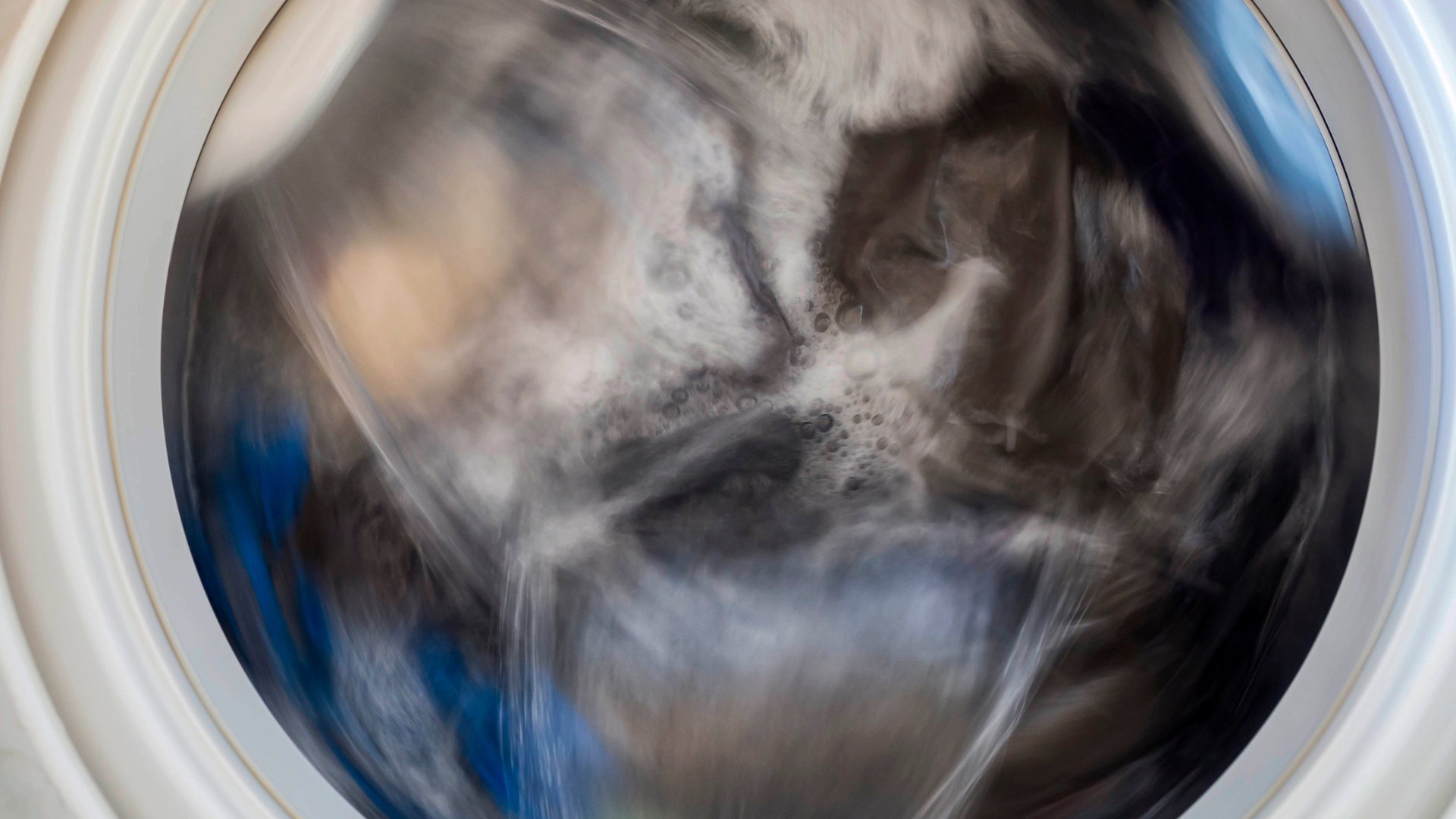A GE washer that will not spin often faces issues with its lid switch or belt. Troubleshooting these parts can quickly solve the problem.
Dealing with a GE washer that refuses to spin can be frustrating, especially when you have a pile of laundry waiting. This common issue disrupts your routine and demands immediate attention. Understanding the root cause is crucial, whether it’s a malfunctioning lid switch, a worn-out belt, or a problem with the motor.
Early diagnosis and repair can save you from a hefty repair bill and extend the life of your appliance. Engaging with this problem effectively requires a blend of patience, a bit of DIY skill, and sometimes professional help. Addressing it promptly ensures your laundry schedule gets back on track without further delay.
Symptoms Of A Non-spinning Ge Washer
A non-spinning GE washer can be a real headache. It’s important to
understand the symptoms. This helps diagnose the issue quickly. Below are key indicators that your GE washer may not spin properly.
Strange Noises
Loud thumps or grinding sounds are common when the washer should spin but doesn’t. These noises suggest a malfunction inside the machine. It could be a problem with the belt or motor.
- Squeaking indicates a worn belt.
- Clicking might point to an object obstructing the drum.
Water Not Draining
Water remaining in the drum is a clear sign of issues. If the washer won’t spin, water can’t be forced out. This could mean a clogged drain or a faulty pump.
| Issue | Possible Cause |
|---|---|
| Stagnant Water | Drainage blockage |
| Drum Full of Water | Broken pump or hose |
Common Causes Behind The Issue
Is your GE washer refusing to spin? You’re not alone. Many factors can halt your laundry plans. Let’s explore the common culprits for this spinning snag.
Faulty Lid Switch
The lid switch is a safety feature. It stops the spin cycle if the lid is open. A faulty switch means no spinning. Check for a click when closing the lid. No click often means a bad switch.
Signs of a faulty lid switch:
- Washer fills but won’t spin
- No clicking sound on lid closure
- Washer won’t start at all
Worn Out Drive Belt
A drive belt makes the tub spin. Over time, belts can wear out. A worn belt may slip or snap. Inspect the belt under the washer for signs of wear.
Indicators of belt issues:
| Sign | What it means |
|---|---|
| Glazed or frayed edges | Belt wearing out |
| Loose belt | Needs tension or replacement |
| Broken belt | Immediate replacement needed |
Quick Fixes You Can Try
Is your GE washer refusing to spin? It’s a common issue but don’t worry. Before calling a technician, try these quick fixes. They are simple and might just solve the problem.
Resetting The Washer
Resetting your GE washer can often fix spinning issues. Here’s how:
- Unplug the washer for one minute.
- Plug the unit back in.
- Open and close the lid six times within 12 seconds.
This should trigger the reset function.
Checking The Lid Switch
The lid switch is crucial for safety. It stops the spin if the lid is open. If faulty, it can prevent spinning.
- Check the switch for any obvious damage.
- Ensure it clicks when the lid closes.
- If no click is heard, the switch may need replacement.

Credit: www.reddit.com
Step-by-step Guide To Replace The Drive Belt
If your GE washer won’t spin, the drive belt may be the culprit. The following guide will show you how to replace it.
Tools You’ll Need
- Socket wrench: For removing bolts.
- Screwdriver set: For various screws.
- Putty knife: To pry open the top panel.
- Work gloves: To protect your hands.
- New drive belt: Match it with your washer model.
Replacing The Belt
- Unplug the washer: Safety first.
- Access the belt: Use the putty knife to open the top panel.
- Remove front panel: Unscrew with the socket wrench.
- Take off the old belt: Slide it off the pulleys.
- Place the new belt: Align it with the pulleys.
- Test the tension: It should be snug but not too tight.
- Reassemble the washer: Reverse the disassembly steps.
- Plug in and test: Run a cycle to ensure proper function.
Troubleshooting The Motor
When a GE washer won’t spin, the motor often needs attention.
Motor problems can halt your appliance’s function.
Learning how to troubleshoot can save time and money.
This guide will help identify and address motor issues.
Signs Of Motor Problems
Recognizing motor problems early is key. Here are some signs:
- Humming sounds: A stuck motor may hum.
- No movement: The tub won’t spin at all.
- Burning smell: Wiring issues can cause a burn odor.
- Error codes: Certain codes indicate motor faults.
How To Address
Here are steps to tackle motor issues:
- Unplug the washer: Safety comes first.
- Access the motor: Remove the back panel.
- Inspect belts: Check for wear and tightness.
- Test the motor: Use a multimeter for continuity.
- Reset the motor: Unplug, wait, and replug.
- Contact support: If issues persist, get professional help.

Credit: fleetappliance.com
When To Call A Professional
Is your GE washer refusing to spin? Sometimes, a professional must step in.
Complex Electrical Issues
Washers rely on intricate electrical systems. These systems can be puzzling. Electrical faults often require expert attention. Symptoms like unresponsive controls or erratic washer behavior hint at deeper issues. Such complexities are beyond the average DIY scope.
Professionals bring tools and expertise. They safely navigate the washer’s electrical maze. Calling them protects you and your appliance. It also ensures warranty preservation, if applicable.
When Diy Fixes Fail
Attempted a fix and it didn’t work? It’s time to call for help. Professionals diagnose problems that DIY might miss. They offer solutions that are lasting.
- Quickly identifies the issue
- Provides a proper fix
- Prevents further damage
Repeated DIY attempts can worsen the problem. This leads to more costs. A professional ensures the job is done right the first time. Trust in their experience and tools for a proper repair.
Maintenance Tips To Prevent Future Issues
Preventive maintenance for your GE washer ensures it spins when needed. Follow these tips to avoid future spin issues.
Regular Cleaning
Keep your GE washer in top shape with routine cleaning. Dirt and detergent can build up. This affects performance. Clean the washer drum monthly. Use a damp cloth for the exterior. Wipe down the door seal. Leave the door open after use. This prevents mold and odors.
Steps to clean your washer:
- Remove any debris from the drum.
- Run a hot water cycle with vinegar.
- Wipe the drum with a microfiber cloth.
- Clean the detergent dispenser.
- Leave the door ajar to dry.
Periodic Inspections
Regular check-ups catch small issues before they grow. Inspect your washer every few months. Listen for unusual noises. Check for leaks. Inspect belts and hoses. Replace worn parts promptly. This keeps your washer spinning smoothly.
Inspection checklist:
| Component | Check For |
|---|---|
| Belts | Wear and tear |
| Hoses | Cracks and leaks |
| Drum | Foreign objects |
| Motor | Unusual sounds |
Understanding Warranty And Support Options
Is your GE washer refusing to spin? Don’t worry! Your machine might still be under warranty. Knowing your warranty and support options can save you time and money. Let’s explore GE’s warranty coverage and how to find authorized repair services.
Ge Warranty Coverage
GE appliances come with a promise of performance. This includes a warranty that covers parts and labor for repairs. The standard warranty typically lasts for one year from the purchase date. It’s important to check your specific model for exact details. Some parts may have extended coverage.
- Limited parts warranty may extend beyond one year
- Original proof of purchase required for warranty claims
- Warranty service must be performed by GE-authorized technicians
Finding Authorized Repair Services
GE has a network of authorized technicians ready to help. These technicians are trained specifically for GE appliances. They understand your washer’s needs.
- Visit the GE Appliances website
- Use the ‘Service & Repair’ section
- Enter your zip code to find local services
Choosing an authorized service ensures your washer is in expert hands. Repairs made by authorized technicians keep your warranty intact.

Credit: m.youtube.com
Frequently Asked Questions
What Causes Ge Washers Not To Spin?
Several factors can cause GE washers not to spin. Common reasons include a malfunctioning lid switch, a worn-out drive belt, or a faulty motor. Overloading the washer or an unbalanced load can also prevent spinning. Ensuring proper load distribution and checking these components can help resolve the issue.
How Do I Force My Ge Washer To Spin?
To force a GE washer to spin, start by ensuring the machine is on. Press the ‘Start/Pause’ button, then select the ‘Drain & Spin’ cycle. Confirm with ‘Start’ to initiate the spin.
How Do You Reset A Washer That Won’t Spin?
To reset a washer that won’t spin, first unplug it for 1 minute. Plug it back in, then open and close the lid 6 times within 12 seconds. This should reset most models. Always check the manufacturer’s guide for model-specific instructions.
What Would Cause A Washer To Wash But Not Spin?
A washer might not spin due to a faulty lid switch, worn-out drive belt, or overloaded drum. Malfunctioning motor couplings or a broken clutch can also prevent spinning. Always ensure the machine is not overloaded and check for any visible damages to these components for a quick fix.
Why Won’t My Ge Washer Spin?
A GE washer may not spin due to a malfunctioning lid switch, a worn drive belt, or an overloaded drum. Check these components for any issues.
Conclusion
Troubleshooting a GE washer that won’t spin can seem daunting, but armed with the right information, it’s a fixable issue. Remember to check for simple solutions first, like load imbalance or a tripped circuit, before delving into more complex repairs.
Regular maintenance can prevent future spin cycle problems, ensuring your machine runs smoothly. For persistent issues, seeking professional help is always a smart move. Keep your GE washer spinning effectively with these insightful tips.





